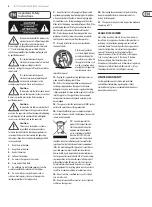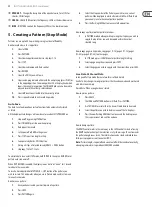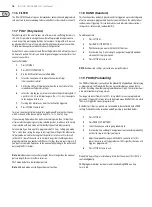
6
RHYTHM DESIGNER RD-9 User Manual
Creative Auto Fill
The auto fill function lets you make on the fly changes and gives that extra touch
to your compositions by adding fills at any point in a song. This gives the RD-9 a
musical edge when it comes to bringing songs to life.
USB Control
To bring the RD-9 into the modern world USB has been added for sync and midi
triggering. The RD-9 can be controlled by a DAW if required. Songs and patterns
exchanged, or individual sounds triggered by the DAW sequencer.
Trigger Happy Controls and Connectivity
The RD-9 has 37 knobs and 58 buttons, all laid out in a highly intuitive
format that puts the fun back into your drum beat creation. Input and output
connections include audio input/output, MIDI input, output and thru over USB
and 5 pin MIDI din ports. With 3 trigger outs (1 assignable) the RD-9 lets you
control external synths and hardware sequencers to create songs without a
digital audio workstation (DAW) in sight. Full live performances can be made
using these extra outputs by controlling other units. The RD-9 can also send
and receive clock information with highly accurate timing to sync it to the
outside world.
You are covered
We always strive to provide the best possible customer experience. Our products
are made in our own Music Tribe factory using state-of-the-art automation,
enhanced production workflows and quality assurance labs with the most
sophisticated test equipment available in the world. As a result, we have one of
the lowest product failure rates in the industry, and we confidently back it up
with a generous warranty program.
3. Front and Rear Panel
Control Layout
3.1 Top Controls
3.1.1 Volume Section
(1)
MASTER
– Controls the main output level.
(2)
PHONES
– Adjusts the headphones level.
NOTE: The headphones signal is taken before the Wave Designer
and Filter for monitoring purposes. This means the Wave Designer
and Filter are not audible in the headphones.
3.1.2 Analog Filter Section
(3)
CUTOFF
– Adjusts the cutoff frequency of the filter.
(4)
HPF
– Toggle the filter between HPF (hi-pass filter) and
LPF (lo-pass filter, default).
(5)
ON
– Engages the filter into circuit when illuminated.
(6)
RESONANCE
– Adjusts the resonance of the filter.
This emphasizes the frequencies around the cutoff point.
3.1.3 Wave Designer
(7)
ATTACK
– Controls the attack portion of the Wave Designer circuit. Turn
counter clockwise (CCW) to reduce the attack portion of the signal and
clockwise (CW) to enhance the attack portion of the selected signal.
(8)
SIG
– Shows that signal is present in the Wave Designer circuit.
(9)
SEND
– Activates the Wave Designer assignment menu. The button is
illuminated when one or more voices are assigned to this bus.
(10)
SUSTAIN
– Controls the sustain portion of the Wave Designer circuit.
Turn CCW to reduce the sustain portion of the signal and turn CW to
lengthen the sustain.
(1)
(2)
(3)
(6)
(4)
(5)
(7)
(8)
(9)
(10)
Содержание RD-9
Страница 38: ...We Hear You ...





















